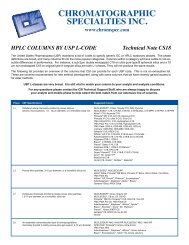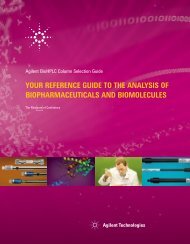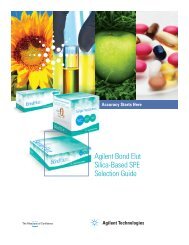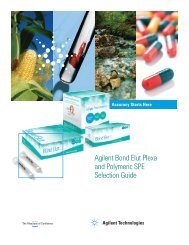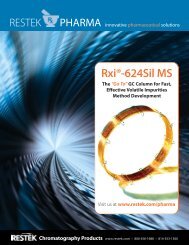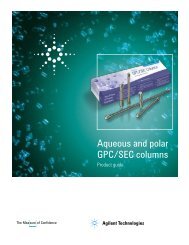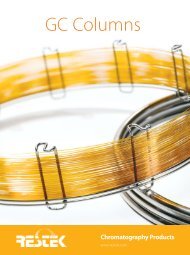Optimizing the Analysis of Volatile Organic Compounds
Optimizing the Analysis of Volatile Organic Compounds
Optimizing the Analysis of Volatile Organic Compounds
You also want an ePaper? Increase the reach of your titles
YUMPU automatically turns print PDFs into web optimized ePapers that Google loves.
28<br />
Ultra-High-Purity Brass<br />
Line Regulator<br />
Use wherever you<br />
need to reduce <strong>the</strong><br />
line pressure by<br />
20psi or more.<br />
Same purity level<br />
as high-pressure<br />
cylinder regulators.<br />
Fitting qty. cat.#<br />
1 /4" female NPT ports* ea. 21666<br />
* Please order appropriate male connector,<br />
pipe-to-tube fittings; see our catalog.<br />
www.restekcorp.com<br />
Figure 25.<br />
Electrolytic conductivity detector: propanol tank with pump.<br />
Drain from Cell<br />
To Pump<br />
To Cell<br />
Out <strong>of</strong> Pump<br />
Propanol<br />
Pump<br />
Figure 26.<br />
With any detector, always be sure that gas flows are adjusted properly.<br />
PID Makeup<br />
H2<br />
PID Purge<br />
ELCD Maintenance and Troubleshooting: ELCD performance depends on <strong>the</strong> reactor temperature,<br />
<strong>the</strong> volume <strong>of</strong> <strong>the</strong> conductivity cell, <strong>the</strong> propanol flow rate, <strong>the</strong> hydrogen gas flow<br />
(Figure 26), and <strong>the</strong> purity <strong>of</strong> <strong>the</strong> solvent system. The goal is to minimize tailing as much as<br />
possible without losing sensitivity. Depending on <strong>the</strong> amount <strong>of</strong> use and <strong>the</strong> types <strong>of</strong> samples<br />
analyzed, <strong>the</strong> nickel reaction tube – <strong>the</strong> reaction catalyst – should be replaced as <strong>of</strong>ten<br />
as monthly. Hydrocarbons and certain o<strong>the</strong>r compounds can “poison” <strong>the</strong> reaction tube and<br />
reduce its catalytic activity. Oxygen and moisture can oxidize <strong>the</strong> reaction tube, affecting<br />
sensitivity. High-purity hydrogen gas is critical for a stable baseline. Use gas regulators with<br />
stainless steel diaphragms and <strong>the</strong> proper purifiers for reaction gases.<br />
A drop in sensitivity (particularly for brominated compounds), baseline instability, or<br />
appearance <strong>of</strong> unknown peaks indicate it might be necessary to replace <strong>the</strong> reaction tube.<br />
Reconditioning <strong>the</strong> reaction tube might restore baseline stability: disconnect <strong>the</strong> PTFE<br />
transfer line, <strong>the</strong>n increase <strong>the</strong> reactor temperature to 1000°C for one hour, <strong>the</strong>n reset <strong>the</strong><br />
reaction temperature to 900°C for re-calibration.





